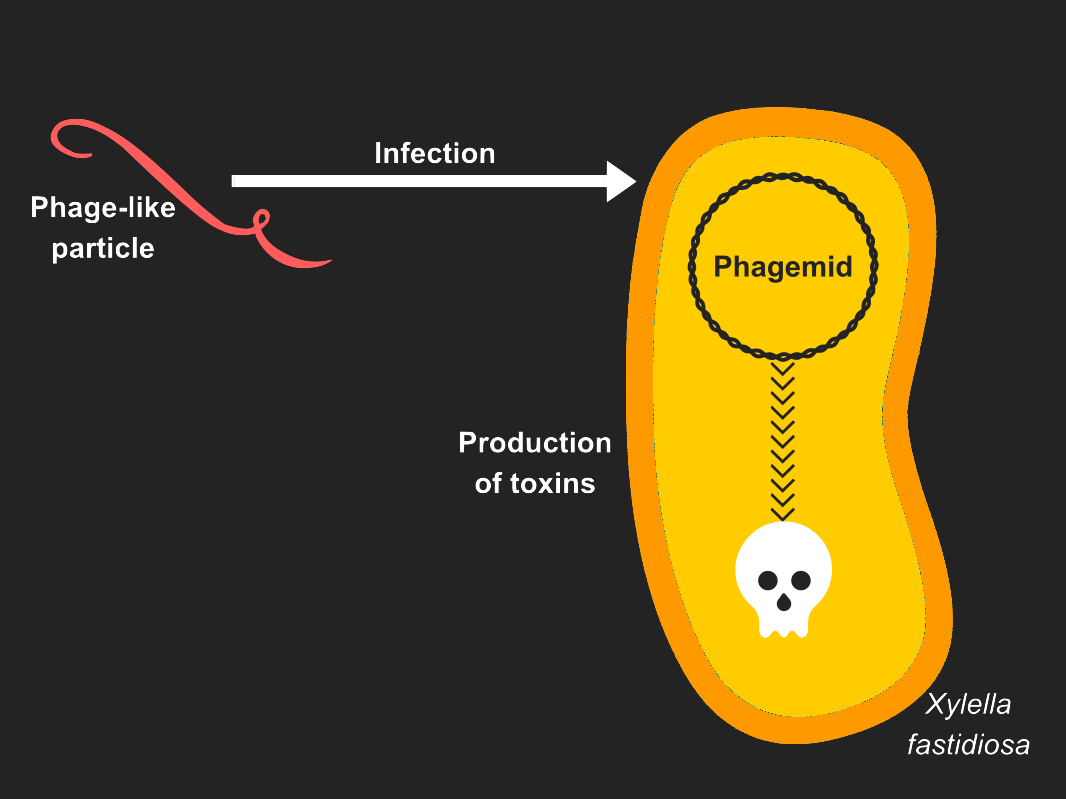(→Phage-like particle design) |
|||
| Line 8: | Line 8: | ||
Phage systems, like [[Team:Aix-Marseille/M13|M13]], have been employed in biotechnological applications, most prominently in the identification and maturation of medically-relevant binding molecules through phage display. The application of phages in materials and nanotechnology is mainly due to their nanoscale size and simple life cycles. We choose to use those application in our advantage in order to target [[Team:Aix-Marseille/Xylella_fastidiosa|''X. fastidiosa'']]. | Phage systems, like [[Team:Aix-Marseille/M13|M13]], have been employed in biotechnological applications, most prominently in the identification and maturation of medically-relevant binding molecules through phage display. The application of phages in materials and nanotechnology is mainly due to their nanoscale size and simple life cycles. We choose to use those application in our advantage in order to target [[Team:Aix-Marseille/Xylella_fastidiosa|''X. fastidiosa'']]. | ||
| − | ==Phage-like | + | ==Phage-like particle design== |
| − | Bacteriophages are able to express their genomes and generate new copies of themselves. We choose to limit the phage ability to reproduce itself in order to contain it. As it is possible to produce recombinant viruses that express foreign proteins, it is possible to restrain their capacity to reproduce | + | Bacteriophages are able to express their genomes and generate new copies of themselves. We choose to limit the phage ability to reproduce itself in order to contain it. As it is possible to produce recombinant viruses that express foreign proteins, it is possible to restrain their capacity to reproduce themselves. <ref name= Silva>Roldão, A., Silva, A. C., Mellado, M. C. M., Alves, P. M. & Carrondo, M. J. T. Viruses and Virus-Like Particles in Biotechnology: Fundamentals and Applications. in Reference Module in Life Sciences (Elsevier, 2017).</ref> |
| − | VLPs mimic the organization of native viruses but lack the viral genome. They have been applied | + | VLPs mimic the organization of native viruses but lack the viral genome. They have been applied as vehicles in drug and gene delivery and as tools in nanobiotechnology. In this project, we want to create a [[Team:Aix-Marseille/M13|M13]] phage-like particle in order to inject toxin in the bacterium. |
[[Team:Aix-Marseille/M13_Design|Learn more about our design...]] | [[Team:Aix-Marseille/M13_Design|Learn more about our design...]] | ||
Revision as of 21:41, 5 October 2017
Engineering bacteriophages
Contents
Bacteriophages play a special role in nanoscale cargo-delivery developments, because they can be regarded as naturally occurring nanomaterials. We choose to explore the Virus-like particles (VLPs) use against pathogenic bacterium like Xylella fastidiosa. Our goal is to use a phage, like M13, in order to inject a lethal toxin into the bacterium.
Phage systems, like M13, have been employed in biotechnological applications, most prominently in the identification and maturation of medically-relevant binding molecules through phage display. The application of phages in materials and nanotechnology is mainly due to their nanoscale size and simple life cycles. We choose to use those application in our advantage in order to target X. fastidiosa.
Phage-like particle design
Bacteriophages are able to express their genomes and generate new copies of themselves. We choose to limit the phage ability to reproduce itself in order to contain it. As it is possible to produce recombinant viruses that express foreign proteins, it is possible to restrain their capacity to reproduce themselves. [1]
VLPs mimic the organization of native viruses but lack the viral genome. They have been applied as vehicles in drug and gene delivery and as tools in nanobiotechnology. In this project, we want to create a M13 phage-like particle in order to inject toxin in the bacterium.
Learn more about our design...
References
- ↑ Roldão, A., Silva, A. C., Mellado, M. C. M., Alves, P. M. & Carrondo, M. J. T. Viruses and Virus-Like Particles in Biotechnology: Fundamentals and Applications. in Reference Module in Life Sciences (Elsevier, 2017).


